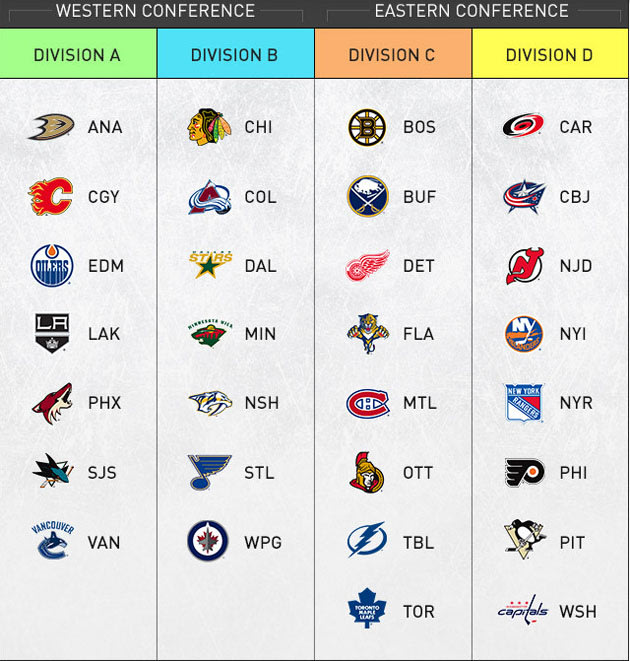Funny how 12 months, an intense labor debate and relatively happy returns from fans can change how things work in the NHL.
When realignment was brought up last season, the NHLPA shot down the proposal citing a number of issues surrounding travel and questions about the playoff format. After burning a major portion of the season to a lockout, the NHL and PA put through a realignment plan for next year that was nearly identical to the one that was vetoed last season.
There are some significant changes to this plan compared to the last proposal. Both Detroit and Columbus come East, leaving the league with unbalanced conferences; a wild card option has been instituted to keep a competitive balance for the playoffs; lastly, the recently approved plan ensures every team will appear in every arena over the course of the year.
The Sabres will welcome three new division rivals to their yet-to-be-named division dubbed as “Division C” in the most recent league graphic illustrating the new conferences. In addition to their current Northeast Division rivals, the Sabres will welcome Florida, Tampa Bay and Detroit to their new division.
The Bolts and Panthers ended up being the black sheep of the entire realignment as they’re geographically hamstrung compared to the rest of the Eastern Conference. Short of splitting them between the two divisions (an unrealistic option), the NHL had limited options with their two Sunshine State franchises. Detroit (along with Columbus) made good on the reported promise made by the league to get them into the Eastern Conference, away from 10:00 starts and into a division with relatively limited travel.
Buffalo will play five games a year against division opponents, three games a year against the other Eastern Conference teams and 28 total against the West.
While the new division alignment doesn’t stack the odds against the Sabres, it doesn’t necessarily favor them either. Finding success within their division may not be as much of a challenge for the Sabres as remaining above those teams from the other Eastern division.
Most concern over the new division centers around the Red Wings. The thought of adding a perennial power to the schedule five times isn’t something any fan would want to think of. Of course, they could’ve ended up with the Penguins and the Wings. If you were truly working out a regionally friendly division, the Wings, Sabres, Penguins and Blue Jackets would be the easiest to group together. Add in the rest of the Northeast (for rivalries) and the division would be set. When you consider that alternative – no matter how bad the Blue Jackets are – just getting the Wings isn’t so bad.
Another thing to consider is that most of the Red Wings core has begun to enter their collective twilight. While they are still one of the league’s premier organizations on and off the ice, this isn’t the team that went to back-to-back Cup finals in 2008 and 2009. In addition to reports that Pavel Datsyuk will return to Russia, Henrik Zetterberg and many others are no longer spring chickens.
Make no mistake, this isn’t a team from the Dead Wings era. They have a number of young prospects who have yet to blossom. There will still be talent wearing the Winged Wheel moving forward, but they won’t be the powerhouse they were five or six years ago.
While the Wings may be nearing a downturn, they remain the class of this division as next season draws near. Detroit, along with Boston will be the favorites to win the division entering next season, the rest of the division could be up for grabs, especially when you consider how much turnover could occur between today and the end of next year.
Just comparing last year and this season provides great evidence of the upheaval this division could see. A year ago Florida’s coaches and management were lauded as geniuses as they ran off with the Southeast Division title while the Canadiens wallowed at the bottom of the league. The pair have flip flopped less than a year late as the Habs are competing for the best record in the east while the Panthers are leading the Seth Jones sweepstakes.
In 12 months the Red Wings could be running away with the Presidents Trophy while the Leafs could easily drift back to the bottom of the conference after this year’s success. This is a game constructed on ebbs and flows. Some team experience more significant change but this is a flowing process. The key for the Sabres will be to reconstruct a competitive roster.
In what can only be described as a down year, the Sabres need to retool a number of positions. The results of this roster turnover will have a major effect as they prepare to enter this new division. If not, they’ll be on the outside looking in more often than not.
As of today, the Sabres, Panthers and Lightning were the three worst teams in the league (points). This is a trend that cannot continue with the new divisional alignments. The wild card playoff stipulation makes things that much harder when you consider the depth of talent in the “Atlantic” division. Even if some of the Atlantic’s up-and-coming teams (Islanders) don’t turn the corner immediately, the upper class will make things difficult for whichever team finishes fourth in the “Northeast”. This makes staying competitive doubly important knowing that the depth of the “Atlantic” increases the difficulty of securing a post season berth.
The key for the Sabres will be to ensure they’re strong enough to compete at the top of their division so they escape the trap that could set in for those teams that finish in the middle of the pack. The Sabres attitude towards building a winner will need to go into high gear under the new conference alignment if they wish to establish themselves as a perennial playoff contender.
Add The Sports Daily to your Google News Feed!